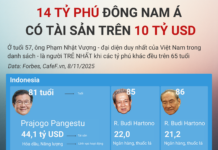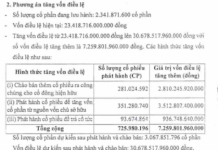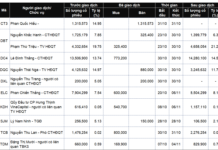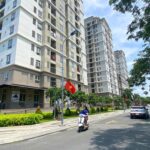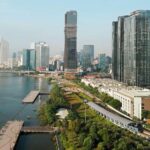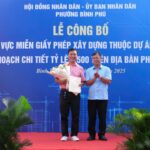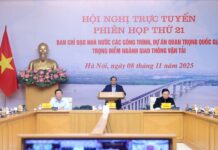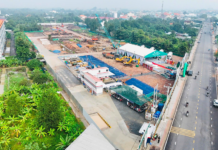At the Ho Chi Minh City socio-economic press conference on July 31st, Mr. Nguyen Tan Phong, Deputy Director of the Ho Chi Minh City Department of Home Affairs, provided an update on the achievements of the local two-tier government model after one month of operation.
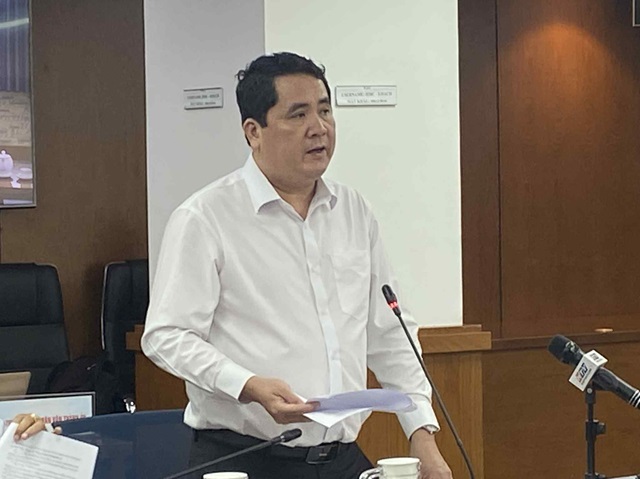
Mr. Nguyen Tan Phong, Deputy Director of the Ho Chi Minh City Department of Home Affairs, shared information after one month of operating the two-tier local government. Photo: Khang Di
|
Perfecting the organizational structure and stabilizing the operations of administrative units
The representative from the Department of Home Affairs stated that the arrangement and organization of administrative units were carried out according to the Central and Municipal Party Committee’s directives. The city has completed the reorganization of its apparatus, allocated officers and civil servants to the new agencies and units, and put the Commune-level Public Administration Service Centers into operation.
The workspaces of the new administrative units have been inspected and rearranged to fit the organizational scale. The management activities in the fields of economy, culture, society, natural resources, and environment, as well as national defense and security, have been basically maintained stable. The reception and handling of administrative procedures have been carried out promptly.
The People’s Committees of the new wards and communes continue to implement the plan for socio-economic development according to the orientation of the locality before the rearrangement. The targets for budget revenue collection and disbursement of public investment capital have been adjusted appropriately. Some localities reported difficulties due to the untimely allocation of the public investment plan.
Streamlining the organizational structure
Mr. Phong shared that the organizational structure of the Ho Chi Minh City People’s Committee (new) consists of 15 specialized agencies (a reduction of 28 out of 43 agencies, equivalent to a 65.11% decrease) and 3 other administrative agencies (a reduction of 3 out of 6 agencies).
Additionally, the city has taken over 58 non-business units as direct subordinates of the People’s Committee and will continue the arrangement in phase 2. Regarding the public non-business units under the People’s Committee, the city will issue a decision to define their functions, tasks, authority, and organizational structure as prescribed.
Promoting administrative reform and enhancing interconnectivity
As of July 1, 2025, the 168 wards, communes, and special districts in Ho Chi Minh City have officially stabilized their operations according to the new model.
The Ho Chi Minh City People’s Committee has temporarily announced 2,357 administrative procedures (TTHC), including 1,997 provincial-level TTHC and 368 commune-level TTHC. All procedures have been updated on the Administrative Procedure Handling Information System and integrated with the National Public Service Portal, enabling online services for citizens and businesses.
The city has also issued a plan to implement Resolution No. 66/NQ-CP on reducing and simplifying administrative procedures related to production and business activities for the period 2025-2026, aiming for 100% of procedures to be performed regardless of administrative boundaries within the provincial scope.
The City People’s Committee has assigned the City Digital Transformation Center to review and evaluate the administrative procedure handling information system to ensure it meets the requirements when performing procedures regardless of administrative boundaries. The Department of Science and Technology and other units have been tasked with inspecting, supplementing, and upgrading the infrastructure and equipment at the One-Door Units for handling administrative procedures without regard to administrative boundaries.
Furthermore, the City People’s Committee has built and perfected the City Public Administration Service Center system toward enhancing service quality, facilitating citizens’ access, and disregarding administrative boundaries in handling administrative procedures.
Addressing policies and regimes for officers and civil servants after rearrangement
“Up to now, Ho Chi Minh City has settled retirement and resignation policies for 2,681 cases according to the regulations in Decree No. 178/2024/ND-CP and Decree No. 67/2025/ND-CP. Of these, 307 are officials, 1,277 are civil servants, and 1,097 are public employees,” said Mr. Phong.
The city has also submitted a plan for assigning the number of civil servants in agencies and organizational units, the number of employees paid from the state budget in public non-business units, and the number of employees paid from the business income of public non-business units in Ho Chi Minh City in 2025.
Some difficulties and recommendations
According to Mr. Phong, in the initial period of implementing the two-tier local government model, this is a new model with many changes in organizational structure, scope, authority, and mode of operation. Therefore, localities are still confused and face difficulties in applying the new regulations.
The team of officers and civil servants at the commune level, especially those who are newly appointed or transferred, have not yet fully updated their knowledge and skills to meet the new requirements. After the merger of three provinces and cities, the area is vast, the travel distance is far, and some workplaces do not yet meet the infrastructure requirements…
Currently, the National Public Service Portal is in the process of connecting and integrating with other national databases and specialized databases. Therefore, some inter-sectoral administrative procedures in the field of household registration cannot retrieve previously stored information to resolve applications for citizens.
The City People’s Committee has sent recommendations to the Ministry of Justice and the Ministry of Home Affairs regarding guidance for localities on decentralization and authorization, job titles after arrangement, and arrangement of accountants at the commune level according to the new model. They have also requested guidance on building job positions for administrative units at the commune level.
Key tasks for the coming period
Ho Chi Minh City will continue to implement solutions to perfect the two-tier local government model, including:
- Complete the organizational apparatus and the team of officers, civil servants, and non-specialist staff; prepare for the organization of Party committees at all levels for the term 2025-2030.
- Inspect, review and guide the conversion of administrative documents related to people’s lives and social security, with the principle of not collecting any fees or charges for this conversion due to changes in administrative boundaries.
- Finalize the personnel arrangement plan and move towards the election of deputies to the 16th National Assembly and the People’s Councils at all levels for the term 2026-2031.
- Support localities in completing shared information technology infrastructure, ensuring the continuity of the administrative procedure handling system and the 1022 reflection and feedback system for citizens and businesses.
- Continue to promote the emulation movement “100 days of operation with streamlined, strong, effective, efficient, and powerful performance” to improve the quality of service for citizens and businesses.
– 21:33 31/07/2025
Unlocking the Pink Book Conundrum: Navigating Through the Challenges to Grant 108,000 Property Titles in Ho Chi Minh City
The task force of Ho Chi Minh City has conducted 33 meetings to address obstacles and facilitate the progress of 176 commercial housing development projects within the city.
The Alluring Grand Marina Saigon: 5 Reasons Why the Ultra-Wealthy are Flocking to this Investment Haven
“As prime real estate in the heart of Ho Chi Minh City becomes increasingly scarce, Grand Marina, Saigon is an exclusive development that boasts five key value propositions. From its iconic location to its luxurious, internationally-acclaimed Marriott-branded residences, this project offers a truly elite lifestyle for its discerning homeowners.”
The Prestige of Lan Anh Avenue: Unveiling a Luxurious Compound in Northeast Ho Chi Minh City
On August 1st, 2025, the groundbreaking ceremony for the prestigious Lan Anh Avenue compound took place in Binh Co Ward, Ho Chi Minh City. This momentous occasion marked a significant step towards creating an exclusive, upscale living environment tailored for professionals and engineers working in the northeastern region of Saigon, conveniently located adjacent to the VSIP III Industrial Park.
Build a House Without a Permit: The Joy of Permitless Building
No more tedious waiting! Residents of Ho Chi Minh City can now commence construction on their homes just three days after notification.











